20180925-6 四则运算试题生成
作业要求参见【https://edu.cnblogs.com/campus/nenu/2018fall/homework/2148】
一.结对伙伴:祝玮琦
二.代码地址:https://git.coding.net/sunsss/two.git
三.要求
要求1:
(1) 给出每个功能的重点、难点、编程收获
①功能1的重点是数字和符号都要随机生成,Python中要运用random标准库进行解决。
②功能2的重点是括号要随机生成,依旧要运用random标准库解决。其中的难点是括号生成的顺序怎么解决,运用while,if来解决。
③功能3的重点是如何使题目不出现重复的情况,用os标准库解决。其中的难点就如何支持小数。
④功能4的重点是支持分数,用os ,fractions的标准库解决,难点真的很多,因为输出的数的类型要为浮点型,生成的分子分母就要要有位数的限制,所以很困难。
(2) 给出结对编程的体会
结对编程是一个相互学习,相互进步的过程。理论上来说,好处有三点,第一结对编程可以提供质量较好的代码,了解别人的思路和想法,从而努力的提高自己的水平;第二结对编程工作效率更高;第三结对编程使得两个人都被迫提高了工作效率。如果我单独工作,在遇到困难的时候,并不是立刻积极地去解决问题,这时或许会上网和网友聊聊天,看看无关的网站等等。有可能因为这种情况的产生,大半天的时间都浪费了。是利大于弊的情况。但就我个人的情况来说,我与我的结对同学,由于我们两个处于一样的水平,初级的学习状态,使得我们两个要花费比单人编程更多的时间,在每一个问题上都有反复的争论,反复的测试,最后在用百度查找的方式来验证观点,方法的对错,整个结对的过程结束后,我们彼此都觉得身心俱疲(请老师不要问我,为什么不找其他的同学结对,首先为了符合老师的要求,结合自身的课余时间,我无法找到其他符合标准的人;其次,比起一个我不熟悉水平的人,不知道什么会什么不会的人,我们两个虽然水平都很次,但是一起生活了很久,已经不用在如脾气,性格,沟通上进行磨合,相比之下,一起编程更有优势)在这个过程中,我认为我们此次过程弊大于利。我会珍惜之后的结对编程,团体合作,用最快的速度进步和成长。
(3) 至少5项在编码、争论、复审等活动中花费时间较长,给你较大收获的事件
第一:由于学习python的时间还不够长,四则运算的难度对我来说很大,加上对编码本就不是很熟练,经过这次作业,感觉编码比上次作业要编的好那么一点点了。
第二:对于题目的理解,我们两个人持有不同的看法。这种分歧出现在功能一和功能二上,我认为这两个功能可以通过编译一个代码来实现,而我的同伴认为这两个功能应该通过两个代码来实现,我们因此参考了一下前几届同学的作业,发现这两种情况都存在,并没有定论。最后我和我的同伴,将两个功能通过两个代码来进行实现。
第三:在编码过程中,由于对题目理解的错误,在最初编码时,自己设定了20道题,并不是要求中的随机生成四则运算,但是结果却是相同的,还因此得意忘形了一会儿,之后发现问题,进行了改正,耽误了较多的时间。
如图所示:
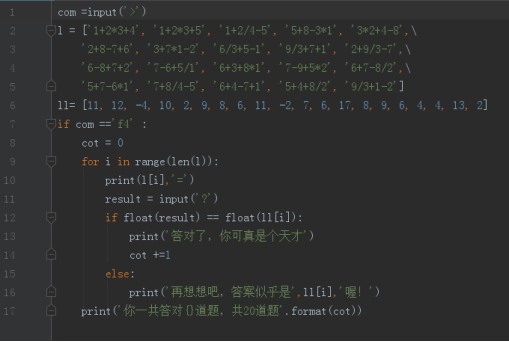
第四:花费时间最多的就是编代码的过程,单人编程的时候许多事情不用在征求别人的意见,但是结对编程中函数的使用,怎么使用等一系列问题都要两个人商量,都要进行尝试证明哪种方法更好。
第五:在测试的运行的过程中,将为文件转化为exe的格式时,电脑一直弹出防火墙进行拦截,期间尝试了很多方法,最终将问题解决了。
要求2 :给出一张照片

要求3:用Git上传
四则运算:
先把代码分别附上:
功能1:
import random ops = ['+','-','*','/'] com = input('>') #用户输入 cot = 0 #答对的题 x = 0 while x < 20 : s1 = random.randint(1,10) s2 = random.randint(1,10) s3 = random.randint(1,10) s4 = random.randint(1,10) op1 = random.choice(ops) #随机运算符 op2 = random.choice(ops) op3 = random.choice(ops) while op1 == op2 == op3: op1 = random.choice(ops) #随机运算符 op2 = random.choice(ops) op3 = random.choice(ops) eq = (str(s1)+op1+str(s2)+op2+str(s3)+op3+str(s4)) res = eval(eq) if len(str(res) ) > 5: continue x += 1 print(eq) in_res =eval( input('?')) if in_res == res: print('算对啦,你真是个天才!') cot += 1 else: print('再想想吧,答案似乎是%s喔!'%res) print('你一共答对%s道题,共20道题'%cot)
功能2:
from random import randint from random import choice ops = ['+','-','*','/'] bra = ['(', '', ')'] com = input('>') #用户输入 cot = 0 #答对的题 x = 0 while x < 20 : s1 = randint(1,10) s2 = randint(1,10) s3 = randint(1,10) s4 = randint(1,10) op1 = choice(ops) #随机运算符 op2 = choice(ops) op3 = choice(ops) """括号""" bra_1 = ['' , '' ,''] bra_2 = ['' , '' , ''] i = ii =0 while (i ==0 and ii ==2) or abs(i-ii)==1 or ii < i : i = randint(0,2) ii = randint(0,2) bra_1[i] = '('; bra_2[ii]=')' while op1 == op2 == op3 : op1 = choice(ops) #随机运算符 op2 = choice(ops) op3 = choice(ops) eq = bra_1[0] + str(s1) + op1 + bra_1[1] + str(s2) + bra_2[0] + op2 + bra_1[2] + str(s3) + bra_2[1] + op3 + str(s4) + bra_2[2] res = eval(eq) if len(str(res) ) > 5: continue x += 1 print(eq) in_res =eval( input('?')) if in_res == res: print('算对啦,你真是个天才!') cot += 1 else: print('再想想吧,答案似乎是%s喔!'%res) print('你一共答对%s道题,共20道题'%cot)
功能3:
from random import randint from random import choice import os ops = ['+','-','*','/'] bra = ['(', '', ')'] com = input('>') #用户输入 com_list = com.split() while com_list[2].isdigit() == False: print('题目数量必须是正整数') com = input('>') #用户输入 com_list = com.split() def xx(): s1 = randint(1,10) s2 = randint(1,10) s3 = randint(1,10) s4 = randint(1,10) op1 = choice(ops) #随机运算符 op2 = choice(ops) op3 = choice(ops) """括号""" bra_1 = ['' , '' ,''] bra_2 = ['' , '' , ''] i = ii =0 while (i ==0 and ii ==2) or abs(i-ii)==1 or ii < i : i = randint(0,2) ii = randint(0,2) bra_1[i] = '('; bra_2[ii]=')' while op1 == op2 == op3 : op1 = choice(ops) #随机运算符 op2 = choice(ops) op3 = choice(ops) eq = bra_1[0] + str(s1) + op1 + bra_1[1] + str(s2) + bra_2[0] + op2 + bra_1[2] + str(s3) + bra_2[1] + op3 + str(s4) + bra_2[2] res = eval(eq) return [eq,res] eq = []; res = [] while len(res) < int(com_list[2]): a = xx() if a[1] in res or len((str(a[1])) ) >6: #结果一样的直接就不要 continue eq.append(a[0]) res.append(a[1]) f= open('题目.txt','w') for i in range(len(eq)): print('{0:15}'.format(eq[i]),end = '') print(res[i]) xxx = 17 - len(eq[i]) f.write(str(eq[i]+' '*xxx)) f.write(str(res[i])+' ') f.close() os.system('题目.txt') #决定是否打开txt
功能4:
import os from random import randint from random import choice from fractions import Fraction ops = ['+','-','*','/'] bra = ['(', '', ')'] com = input('>') #用户输入 com_list = com.split() while com_list[2].isdigit() == False: print('题目数量必须是正整数') com = input('>') #用户输入 com_list = com.split() def xx(): s1 = randint(1,10) s2 = randint(1,10) s3 = randint(1,10) s4 = randint(1,10) op1 = choice(ops) #随机运算符 op2 = choice(ops) op3 = choice(ops) """括号""" bra_1 = ['' , '' ,''] bra_2 = ['' , '' , ''] i = ii =0 while (i ==0 and ii ==2) or abs(i-ii)==1 or ii < i : i = randint(0,2) ii = randint(0,2) bra_1[i] = '('; bra_2[ii]=')' while op1 == op2 == op3 : op1 = choice(ops) #随机运算符 op2 = choice(ops) op3 = choice(ops) eq = bra_1[0] + str(s1) + op1 + bra_1[1] + str(s2) + bra_2[0] + op2 + bra_1[2] + str(s3) + bra_2[1] + op3 + str(s4) + bra_2[2] res = Fraction(eval(eq)) return [eq,res]
运行截图:
功能1:
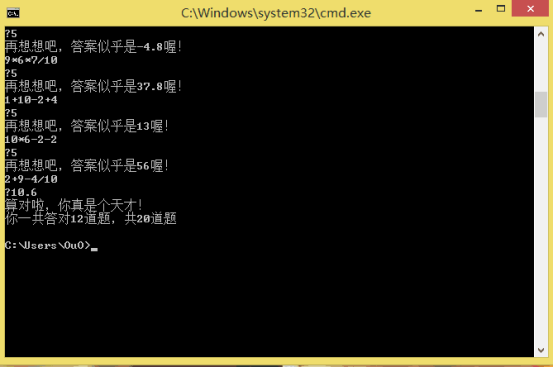
功能2:
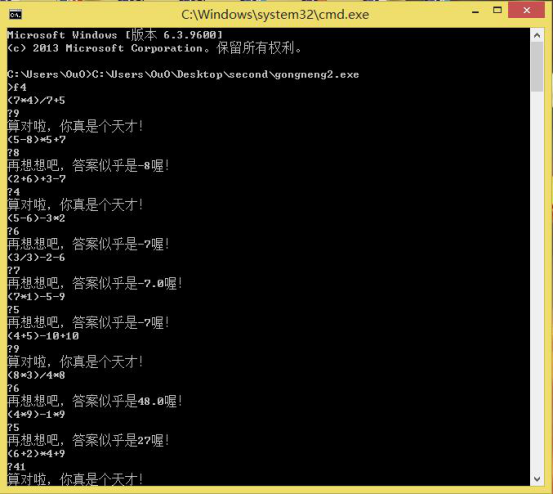
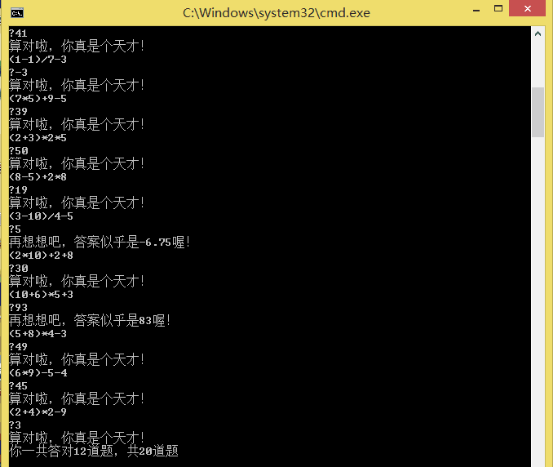
功能3:
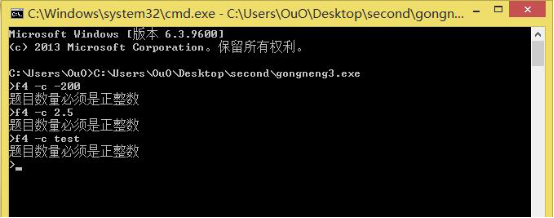
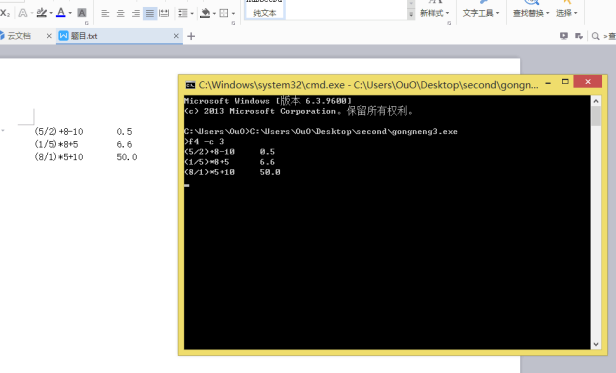
功能4:
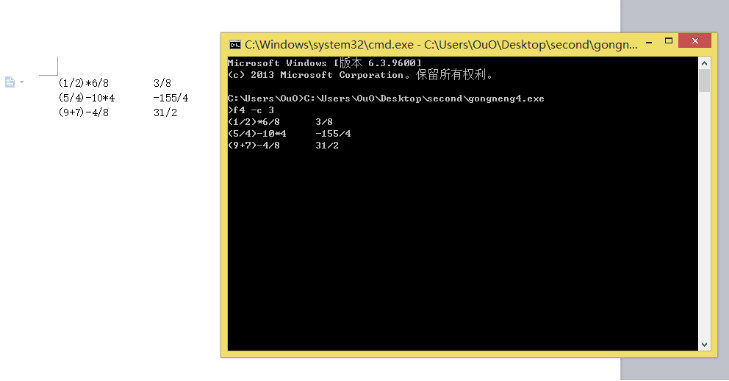
结对编程环境:
软件:pycharm
地点:寝室